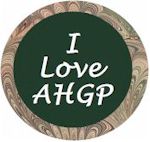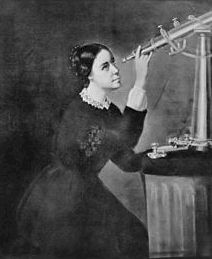|
 |

Part of the American
History & Genealogy Project |
Maria Mitchell 1818 ~ 1889


Maria Mitchell
Miss Mitchell was born on the island of
Nantucket; August 1, 1818 and was one of ten children, her
parents, William and Lydia Mitchell, living in one of the simple
homes of this quaint New England spot. Her father had been a
school teacher, her mother, Lydia Coleman, was a descendant of
Benjamin Franklin, whose parents were Quakers. She was one of
the pupils in her father's school, and by him led into the great
love of nature which opened up for her the opportunity for her
great talents, and to this we are indebted for what she has
given to astronomy.
He gave Maria the same education which
he gave his boys, even the drill in navigation. At sixteen she
left the public school, and for a year attended a private
school, but being deeply interested in her father's studies, and
the study of mathematics, at seventeen she became his helper in
the work which he was doing for the United States Government in
the Coast Survey. This brought to their home Professor Agassiz,
Bache and other noted men. Mr. Mitchell delivered lectures
before a Boston society, of which Daniel Webster was president,
but scientific study and work at that time brought little money
to the family coffers.
One sister was teaching for the
munificent sum of three hundred dollars a year. Maria felt she
must do her part toward adding to the family income, so accepted
a position as librarian of the Nantucket library, her salary for
the first year being sixty dollars, and seventy-five for the
second, and for twenty years she occupied this position, her
salary never exceeding one hundred dollars a year. This gave her
great opportunity for study, which no doubt reconciled her to
the poor pay.
On a night in October, 1847, while
gazing through the telescope, as was her usual custom for the
love of the study, she saw what she believed to be an unknown
comet. She told her father, and he at once wrote to Professor
William C Bond, Director of the Observatory at Cambridge,
notifying him of the fact, merely asking a letter of
acknowledgment in order to please Maria.
It was promptly acknowledged that she
had made a new discovery, and Frederick VI, King of Denmark,
having six years before offered a gold medal to whoever should
discover a telescopic comet, awarded this medal to Miss
Mitchell, the American Minister presenting her claims at the
Danish Court. She was soon gratified by seeing her discovery
referred to in scientific journals as "Miss Mitchell's comet."
She assisted in compiling the American Nautical Almanac, and
wrote for scientific periodicals, but she could not content
herself with the small opportunities afforded her in this New
England village.
In 1857 she went abroad to see the
observatories of Europe. The learned men of Great Britain
welcomed her. She was entertained by Sir John Herschel, and Lady
Herschel, Alexander Von Humbolt, Professor Adams, of Cambridge,
Sir George Airy, the astronomer royal of England, who wrote a
letter of introduction for her to Leverrier of Paris. Later she
visited Florence, Rome, Venice, Vienna, and Berlin, where she
met Encke. After a year of such triumphs she returned to
Nantucket. In 1860 her mother died and the family removed to
Lynn to be nearer Boston, where she could pursue her work under
better conditions.
Miss Mitchell received at this time five hundred dollars a year
from the government for her computations. About this time
Matthew Vassar was founding and equipping the woman's college
that now bears his name.
After the observatory of this
institution was completed there was but one person mentioned or
desired by the patrons and students to be placed in charge, and
this was Maria Mitchell. Miss Mitchell moved to the college and
made it her home.
In 1868, in the great meteoric shower
she and her pupils recorded the details of four thousand meteors
and gave valuable data of their height above the earth. She gave
valuable observations on the transit of Venus, has written on
the satellites of Saturn, and on the satellites of Jupiter.
She died on June 28, 1889, and was
buried in the little island village, where most of her life had
been passed.
Women of
America

Source: The Part Taken by Women in
American History, By Mrs. John A. Logan, Published by The Perry-Nalle
Publishing Company, Wilmington, Delaware, 1912.
|